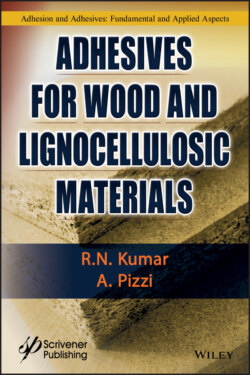Читать книгу Adhesives for Wood and Lignocellulosic Materials - R. N. Kumar - Страница 37
Chapter 2 Fundamentals of Adhesion 2.1 Introduction
ОглавлениеAdhesion is a multidisciplinary science involving various subjects such as rheology, materials science, organic chemistry, polymer science, and mechanics. Study of fundamentals of adhesion is essential as it leads to better understanding of the factors controlling the performance of the bonded assemblies [1].
Wood is a complex substrate, and it is hard to understand why some adhesives work better than other adhesives, especially under stringent durability tests.
The recent trend in the wood industry is to use smaller-diameter logs and employ other lignocellulosic raw materials to produce more versatile and environmentally acceptable green engineered wood products. This in turn increases the complexity in the choice of adhesives. In order to provide a scientific basis to make the correct choice of adhesives and their formulations, a study of the fundamentals of adhesion is essential.
A clear understanding of wood adhesion mechanisms will enable production of better adhesive and formulation systems suitable for a wider array of wood composite materials. The study of the fundamentals of wood adhesion is essentially distinctive and unique and involves multidisciplinary sciences with respect to both the adherend, the adhesives, and their interactions. The uniqueness of wood as an adherend by virtue of possessing a hierarchical structure has already been dealt with in detail in Chapter 1. In this respect, wood differs significantly from other substrates such as metals, plastics, elastomers, etc. Surface science, rheology, materials science, surface chemistry and surface morphology, organic chemistry, polymer science and polymer characterization, and solid mechanics and interaction between polymers and wood—all contribute to the development and understanding of the adhesion phenomenon.
Further, these studies will enable
The identification of practical problems and root causes for adhesion failure and provide practical preventive solution from the knowledge of the nature of wood–adhesive interaction, i.e., a scientific approach to troubleshooting.
Optimization of the performance of existing adhesives and to develop new adhesives to meet stringent environmental regulations.
The increase in the durability of bonded wood products by precisely understanding the role of internal and external stresses to which wood bond lines are subjected.
The development of new technologies based on the insights gained from the knowledge of the basic principles, which can be applied efficiently for bonding difficult to bond wood species and preservative treated wood. This is so that the carbon sequestration is possible for prolonged periods of time to reduce the global warming potential of wood products.
